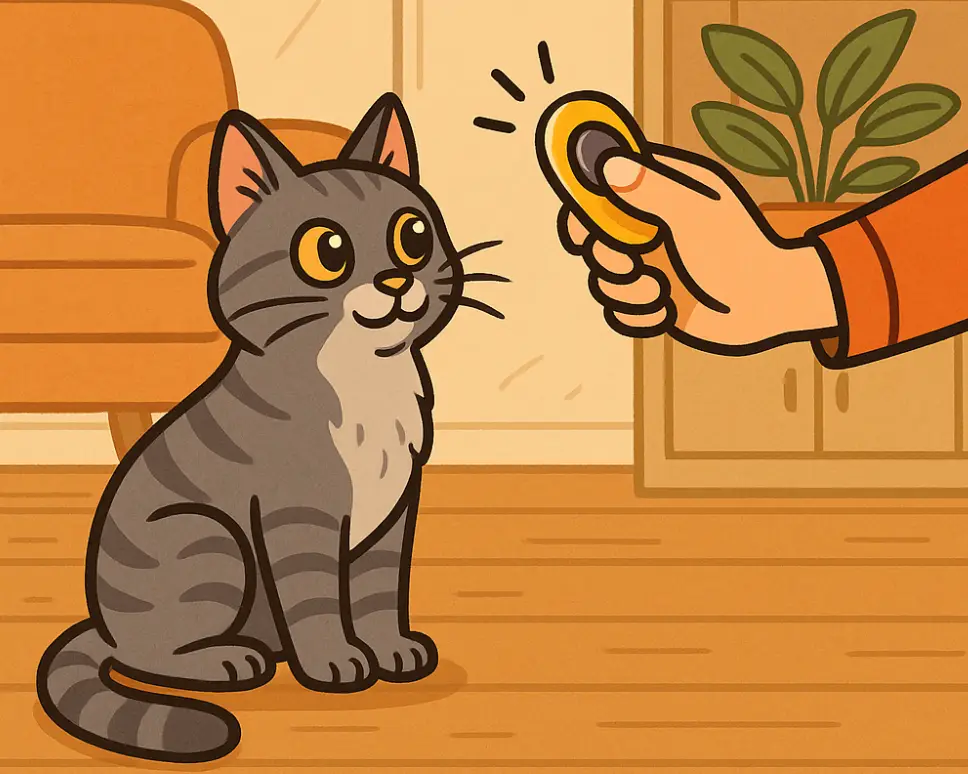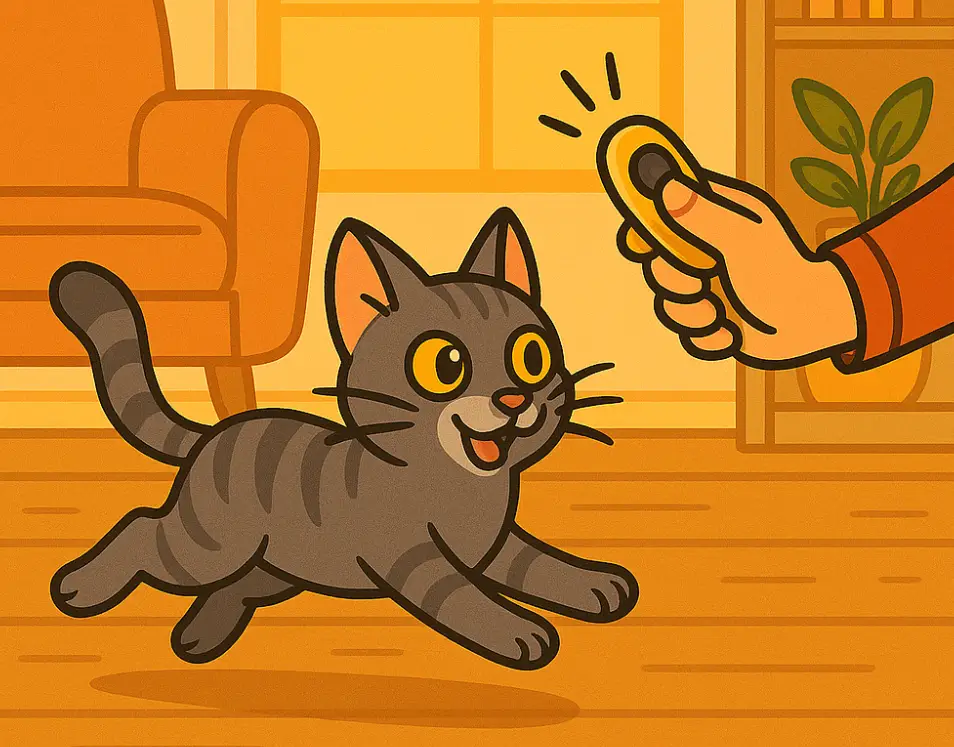Clicker training isn’t just for dogs. Cats pick it up pretty quickly, too. All you need is a bit of patience, a small clicker device, and your cat’s favorite treats. If you take the right approach, you can encourage all sorts of fun and really helpful behaviors, whether you want your cat to sit, jump, target your hand, or come running when you call.
 freeze-dried
freeze-dried
Why Try Clicker Training With Your Cat?
Clicker training uses positive reinforcement to communicate with your cat in a way they really respond to. When your cat does something right, you press the clicker and follow up with a treat. Your cat soon learns that the click means “I did it!” and will be more likely to repeat that behavior. This kind of training taps into your cat’s curiosity and keeps sessions upbeat and rewarding.
Plenty of cats enjoy clicker training because it gives structure and mental exercise. It’s also a great way to deepen your bond. When my cat figured out how to ring a bell on command, we both felt pretty accomplished. Plus, it’s a handy way to redirect not-so-welcome behaviors (like persistent meowing during dinner or scratching your couch) in a calm, positive, and productive way.
Getting Started With Cat Clicker Training
First things first, get your supplies ready. Here’s your quick checklist for a smooth start:
- Clicker: This is a small plastic tool that makes a crisp, consistent “click” noise. You could try clicking a ballpoint pen or making a clicking sound, but a clicker works best since the sound stands out.
- Treats: Keep them tiny, soft, and super tasty. Favorite choices include freeze-dried chicken or squeezable treats. Remember, smaller is better to keep your cat from filling up.
- Quiet Space: Find a calm spot where your cat won’t get distracted. For those first sessions, turn off the TV, tidy up the toys, and keep other pets away.
Stick to a few minutes at a time, just once or twice each day to keep your cat’s attention sharp. If your cat walks away or seems bored, finish the session while things are still fun.
Basics: How Clicker Training Works
Clicker training comes down to three simple steps:
- Mark the behavior: When your cat does the thing you want, like sitting or touching your hand, click right at that instant.
- Give a treat: Quickly follow up the click with a treat. You’ve got to be speedy; waiting too long can confuse your cat.
- Repeat: Practice a few times to keep your cat excited and clear on what’s expected. Always pair the click with a treat at the beginning.
That’s the heart of clicker training. Soon, you can teach new behaviors using “shaping” (rewarding tiny steps toward a goal) or “capturing” (clicking when your cat does something by chance and rewarding it).
Easy Tricks and Helpful Behaviors To Try First
Not sure what to teach? Check out these beginner moves many cats pick up quickly:
- Sit: Hold a treat just above your cat’s head. Generally, your cat will sit to reach it. Click and treat for sitting.
- High Five: Offer your hand to your cat. If they touch it, click and treat. Raise your hand a bit higher as they get the hang of it.
- Target: Use a pen or chopstick. Encourage your cat to tap it with their nose. Each touch gets a click and a treat.
- Come When Called: Start out close by, use your cat’s name, and reward them for coming over. As they get better, gradually increase the distance.
Teaching these basics keeps your cat’s mind sharp and helps them feel proud. Plus, it makes future situations, like vet visits or nail trims, smoother and less stressful.
Tips To Help Training Go Smoothly
- Keep sessions short: Three to five minutes is enough for most cats. If your cat walks away, just save it for later.
- Train when your cat is alert but not hyper: Try before mealtime, when your cat is hungry and tuned in, but not frantic.
- Switch up treats: Trying out different rewards keeps things fresh. Some cats prefer freeze-dried meat, others prefer soft treats or cheese—always keep treats tiny, though.
- Be patient: Cats learn at their own speed. Some catch on quickly, while others prefer to watch first.
Pushing your cat or expecting instant progress will only frustrate both of you. Consistency pays off in the long run.
Common Training Challenges
(And How To Work Around Them)
Clicker training cats isn’t without special quirks. Here’s how to deal with popular roadblocks:
- Cat walks away mid-session: That usually means your cat’s bored, full, or not feeling it. Try again later when your cat’s mood is more playful or hungry. End sessions with a win, even a small one.
- Clicker is too loud: If your cat is startled by the sound, try muffling it, or go for a softer clicker (or even use a soft “mouth click”) until they’re at ease.
- Cat not motivated by treats: Try different treats or work before meals when your cat cares most. Really tasty (even stinky) options usually do the trick.
Adapting training, watching your cat’s mood, and changing your pace are key. Remember, patience and flexibility make all the difference.
Motivation and Consistency
Clicker training only works well if you’re consistent. That means saying the same commands and using identical cues every time. If more than one person is working with your cat, make sure you’re all on the same page with methods and words. It helps the cat stay clear about what you’re asking.
Praise can be as powerful as food! Besides treats, some cats love scratching just behind the ears or under the chin. Don’t be shy about trying various positive rewards to keep motivation high.
Advanced Cat Clicker Training Ideas
Ready to step it up? When your cat knows the basics, try these fun or practical skills:
- Jump Through a Hoop: Place a hoop close to the floor and click for any step through. Lift it slowly as your cat gets the concept.
- Go To a Mat: Every time your cat steps on a mat, click and reward. This “place” command helps your cat have a safe area during commotion or for vet trips.
- Shut Drawers or Doors: Many cats love pawing at things. Click and treat when they push a drawer, then slowly turn that movement into a full close, step by step.
Building complex tricks just means breaking tasks into smaller and smaller steps—and noticing every bit of progress along the way. It’s an awesome chance to challenge your cat’s mind while having fun together.
Real-World Uses For Clicker Training
Don’t think clicker training only means party tricks. I have personally used it to make brushing my cat smooth and stress-free. By rewarding short stretches of sitting still, then slowly increasing time, grooming is now a routine, not a battle. Others use clicker training to teach cats to walk into carriers, hop on a scale at the vet, or even stroll calmly on a leash.
Clicker training also works for those not-so-great behaviors, like jumping on counters or scratching the wrong spot. Guide your cat toward approved places and reward them for using them; no need to scold or raise your voice.

FAQs About Cat Clicker Training
Q: How old should my cat be to start clicker training?
A: Most kittens can learn as young as 8 weeks, if you use small treats and short, peppy sessions. Adult cats and seniors pick it up, too.
Q: Do I have to use a clicker forever?
A: Not at all. Once your cat knows a trick well, slowly cut back on the clicker and only treat sometimes, or swap to praise and petting.
Q: What if my cat just ignores me during training?
A: This usually means your cat isn’t in the mood, isn’t hungry, or isn’t excited by the treat. Try something new, move somewhere quieter, keep sessions short, and stay positive. Sometimes, all you need is a little break.
Final Thoughts
Clicker training is a fun, pressure-free way to teach your cat new tricks and build a stronger connection. Start simple and move up at your cat’s own pace. Before long, training time will be something you both look forward to. With patience, plenty of good vibes, and a laid-back attitude, you’ll probably be amazed by how much your cat can pick up.
When you’re ready for another session, grab your clicker, have treats handy, and see what cool things your cat feels like showing off.
